
Common name:Silver Mound Artemisia
Botanical name:Artemisia schmidtiana 'Silver Mound'
This mounding perennial will grow 1'-3' high and has medium-sized silvery white leaves with yellow and white flowers.
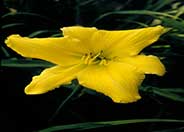
Common name:Daylily, D. Moon Hybrid
Botanical name:Hemerocallis 'D. Moon'
This Daylily has clear yellow blooms above handsome foliage. It has even bloomed in January!

Common name:Lavender Cotton
Botanical name:Santolina chamaecyparissus
This ground cover/small shrub will grow to 2' tall and has small, grayish silver leaves with yellow flowers that bloom in the summer.
Maintenance Tips
Santolina chamaecyparissus is a Mediterranean native that can be found in many California gardens. It is very drought tolerant and is very low maintenance if it is planted in a location where it can reach its full mature size of 2’ tall to 3’ wide. This plant is susceptible to root rot or fungal diseases if the soil is too wet or doesn’t drain easily. If the plant develops fungal issues, allow the soil to dry out and treat with a systemic fungicide. This plant usually blooms in the summer, and the plant will continue to bloom if you deadhead the spent flowers. In the late winter or early spring, you can cut back the foliage by one-third of the current size to maintain the size and encourage new growth.
Common name:Butterfly-Iris, Fortnight Lily
Botanical name:Dietes iridioides
This clumping evergreen Iris bears tall, narrow leaves to 30" tall and white flowers marked purple in the center on stalks up to 3' tall. This variety has stiffer, darker foliage than the bicolor form. It requires sun to part shade with little or no summer watering when established.
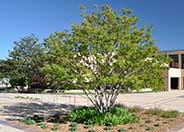
Common name:Crape Myrtle
Botanical name:Lagerstroemia indica
The new leaves of this species are 2" long, bright green, and tinged with bronze. Some cultivars have spectacular fall color. When it has a bare outline, its rounded seed capsules add interest. Its delicate flowers bloom in 6"-12" long clusters. The flower colors could be shades of red, rose, pink, purple, and white, blooming in summer. It thrives on heat, and new cultivars have been created that resist mildew. This tree prefers full sun and has low watering needs once it's established.
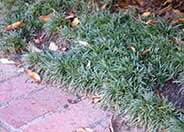
Common name:Mondo Grass, Lily Grass
Botanical name:Ophiopogon japonicus
This Ophiopogon japonicus is a grass-like plant growing to about 6"-8" high. Its leaves are 1/8" wide, and about 8"-12" long. It makes a beautiful ground cover or accent plant, and does well in Asian style gardens.

Common name:Fox Tail Agave, Velvet Agave
Botanical name:Agave attenuata
This Agave has a dramatic tropical form. Even light frost can damage its succulent leaves. It is great for containers. In the low desert, partial sun will be best. If it becomes top heavy, simply cut and stick in the ground to root. It is not a fast grower and has light green foliage. It will also die after flowering but pups around the mother will survive. Distinctive with its large rosette of leaves perched on a long curving trunk, it is a native from Mexico.

Common name:Myers Asparagus
Botanical name:Asparagus densiflorus 'Myers'
An evergreen groundcover, the 'Myers' also makes an excellent hanging basket plant when larger in size. Its formal looking fronds have an even, spiral arrangement of leaflets. It is damaged by severe frosts, and looks best with at least occasional watering.
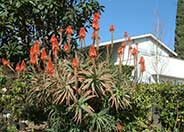
Common name:Tree Aloe
Botanical name:Aloe arborescens
This shrub is large, full of branches and produces deep orange blooms. The flowers produce a nectar that is attractive to many different birds; this plant is grown all over the world.
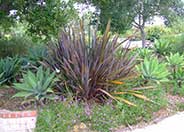
Common name:New Zealand Flax, Purple
Botanical name:Phormium tenax 'Atropurpureum'
Phormium tenax 'Atropurpureum' is an evergreen perennial. Big, dramatic plant composed of many swordlike, stiffly vertical leaves can reach 5' tall. Leaves are purple red. Flowers stems reach high above leaves, bearing clusters of 1"-2" blossoms in dark red.
Maintenance Tips
Phormium tenax 'Atropurpureum' is one of the most popular hybrids of Flax. This variety matures at 4-6' tall and wide. The leaves are strap-shaped, and deep purple, tall flower stalks appear in the summer up to 10' tall. To keep the maintenance as low as possible, plant in a location that is full sun, and well-drained and give it the space it needs to reach maturity. These plants are often the victim of poor pruning habits, with gardeners cutting the leaves off in the middle or shearing them because they are too large for the space they have been given. If this is the case, they should be transplanted to a location where they can reach their full size, or other plants around them should be moved out of their way. Old leaves rarely fall off of the plant, so removing them as they age will help keep the plant looking and performing its best.Designer: California Native Garden
Photographer: GardenSoft